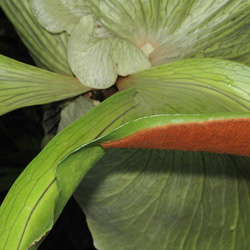Platycerium superbum
 plant in cultivation on Angophora tree |
 spore patch on fertile frond |
Staghorn Fern
Platycerium superbum de Jonch. & Hennipman (1970)
 Known as the Staghorn fern Platycerium superbum is native to lowland rainforests in Queensland and northern New South Wales.
Known as the Staghorn fern Platycerium superbum is native to lowland rainforests in Queensland and northern New South Wales.
Assigned to the Polypodiaceae family, Platycerium is one of 11 genera of this family represented in Australia. The distribution of this genus not only includes species in Australia but includes 14 other species from Asia to New Guinea, Africa and one species in America.
Australia has 4 species including P. bifurcatum which is also very popular in cultivation. Both species do equally well in the tropical and sub-tropical regions of eastern Australia and with protection can be grown successfully in temperate regions such as Victoria.
As with other Platycerium species P. superbum is an epiphyte (grows on trees) or occasionally lithophytic (growing on rocks). Although the fern can look like a tangle of antlers at first, on closer inspection one can see the impressive ‘nest’ frond which can be 1m across at maturity. This ‘nest’ frond is designed to collect falling leaves and insects. These give the fern a valuable source of potassium and calcium, nutrients required for the production of their large fronds. It is from this frond that the fern attaches itself to the host tree. It protectively wraps around the rhizome and short roots, clasping onto the furrows in the bark with root like structures.
The fertile antler fronds emerge from low on the nest frond and can grow down to 2m in length at maturity. They are broad and multi branching in habit, hence the common name ‘Staghorn’. Midway along these fronds during summer the fern produces a mass of spores. This, along with its general size, is a distinguishing character for the species.
In cold areas such as Melbourne, where growing this species is at its southern most point, keep the fern on the ‘dry side’ during winter, especially when young as they are prone to rotting. In its native habitat it is accustomed to a long dry season, but it is also important to give it plenty of air circulation, moderate humidity, and sunlight. These are important requirements for this genus and will therefore be important factors in the success of this plant’s growth.
There are many ways to grow this fern although most are bought in small pots where the nest frond will have to mature before producing fertile fronds. Do consider the weight of these plants. It is popular to grow them mounted onto hardwood boards and hung up on a trellis or planted in a hanging basket suspended from a secure point on the ceiling. In warmer areas they can be attached directly to the trunk of a tree in the garden.
Unlike many species P. superbum doesn’t produce plantlets (pups) which is normally the quickest method to produce new plants. If you wish to propagate new plants then spore propagation is the only method available. To see detailed notes on propagation for this fern please go to the Platycerium bifurcatum page (http://www.anbg.gov.au/gnp/interns-2004/platycerium-bifurcatum.html).
The basic principles are to firstly ensure all material is collected fresh and ripe. The spores change colour through their life, starting off green (unripe), shiny brown (ripe) to fuzzy/ dry brown (spores dispersed). Collect the section of frond with spores into a paper bag. Sow onto a layer of sterilized coir based compost. You could try sterilizing broken down fern material; preferably of the same species as if it is not adequately sterilized you may find the other species growing in competition with your fern.
The easiest containers to use are full sized seed trays. They have a few drainage holes and can be easily sterilized with hot water. To ensure they stay sterilized wear disposable rubber gloves and place the spores on the compost mix as soon as sterilized. Then place under a glass sheet (for light).
Text by Pippa Lloyd (2006 Student Botanical Intern).
Derivation of the name: Platycerium superbumPlatycerium - is derived from the Greek words platys meaning "flat" and ceras meaning "a horn", referring to the shape of the fronds. superbum - .from the Latin superbus meaning 'superb'. |
References
Chaffey, C. (1999) Australian ferns: growing them successfully. Kangaroo Press, New South Wales.
Bentham, G. (1878) Platycerium, Flora Australiensis 7:780-781.
Hennipman, E. and Roos, M.C. (1982) A monograph of the fern genus Platycerium (Polypodiaceae). Verhandelingen der Koninklijke Nederlands Akademie van Wetenschappen, Afdeeling Natuurkunde, Tweede Reeks 80: 1-126.
Hoshizaki, B.J. (1972) Morphology and phylogeny of Platycerium species, Biotropica 4:93-117.
Kreier, H.-P. and Schneider, H. (2006) Phylogeny and biogeography of the staghorn fern genus Platycerium (Polypodiaceae, Polypodiidae), American Journal of Botany 93(6): 217-225.
![An Australian Government Initiative [logo]](/images/austgovt_brown_90px.gif)

